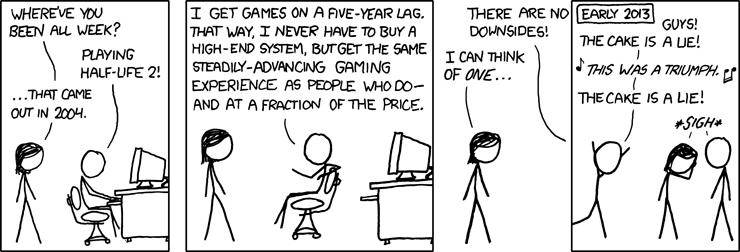As I said in my last post, I went and tested the PS Vita in Japan. I did this on the 16th, which incidentally was the day before release day. That, coupled with the fact that it was a normal weekday, meant that there were no queues at all in Sony Building. Nevertheless, I was ushered into a dark room with black walls and subdued lighting, lined with pillars that each had a PS Vita connected to them, as well as a pair of headphones, with a badge and a timer that gave me 15 minutes to test a game of my choice. Not having any prior information or idea about the games at launch, I eschewed the “traditional Playstation console series release racing game aka Ridge Racer” and went with Gravity Daze.
Gravity Daze was quite interesting, though I’m not sure the novelties would keep fresh long enough to make it a great game. My Japanese is pretty hit-and-miss, and I rushed because I wanted to see as much as I could in the allotted 15 minutes, so I didn’t get the full story. You have to find a black cat and then get introduced to your gravity-defying super power (whether or not you had it before, or the mysterious cat gave it to you, I missed). Basically, a hit on the right shoulder button lets you levitate. You can then look around with the analog stick, and tilt gravity to the side, allowing you to run up a building, jump over to the next, and so on. Hitting the left shoulder button restores gravity for you. The game then made me follow another character and fight enemies by levitating, and then using my gravity control to kick stuff until it was dead. It might actually be a nice game, but I reached the end of the demo after 13 minutes. (so I could’ve spent more time reading! damn!)
The game suffered a bit from a typical problem for games that release with a new console: they seemed to cram a couple of gimmicks into it to showcase the new technology. As far as hardware goes, the PS Vita is basically an upgraded PSP. It’s almost the same size (maybe a bit smaller and lighter than the original PSP), but now comes with a touchscreen. I guess somebody at Sony decided that everybody needs a touchscreen these days, and that they should follow the example of the Nintendo DS. Anyway, at some point in the game, you were supposed to collect things by tapping on the screen with your finger. Now, I’m not a huge fan of touchscreens. They need constant cleaning and such. I’m more a button person. Besides, it felt like you might have collecting thing just as easily by running over them (maybe that is even possible, but it wasn’t advertised).
Definitely the weirdest part of the hardware built into the PS Vita is the rear touchpad, though. Yes, the Vita doesn’t only have a touchscreen. No, Nintendo already had that before, so they needed something even better at Sony! So they installed a touchpad… into the back of the Vita. Hm. It sounds like a very weird idea. I sadly had no opportunity to test it out, because neither Gravity Daze nor Shinobido 2, the other game I tried (where I totally got lost after about 5 minutes, so I gave up) seemed to support it. Come to think of it, though, it might actually be a neat idea. If you’re like me and don’t like touchscreens because of the fingerprints on your screen, you could use the back touchpad as if you touched the screen from behind. There was a tech demo that seemed to hint at exactly that use. It would be neat. I just wonder whether the average human has enough hand-eye coordination to hit the right spot immediately all the time. I would rather try that out first, I don’t trust myself enough here!
On the “evolution rather than revolution” front, the PS Vita got a second analog pad, moving it closer to how the “big” playstation controllers work. I think except for a second pair of shoulder buttons and the ever-annoying “L3” and “R3” buttons that require you to push the analog sticks, everything is there now. That should make ports easier. The second analog pad was the thing I missed most whenever I played on my PSP.
Would I buy a PS Vita? Well, seeing how I had the chance last week, and would’ve gotten bragging rights as the first person I know to have one (I imagine people crowding around me, forming queues to play just a little bit, trading the lunch their mum packed them for just one more minute… ok, getting carried away there!), and still didn’t buy it… I probably won’t. I liked my PSP, but I never played it that much in the end. I think after a certain age, handheld consoles only make sense any more if you spend a lot of time commuting on public transport. That’s probably the reason handhelds are so immensely popular in Japan, but not so much here. If I lived there and had a 30-60 minute commute each way, I’d definitely get one. As things are, my commute is less than 10 minutes by bus. I’d rather play at home on a big screen. I just won’t get enough out of the Vita to spend my money on it.



